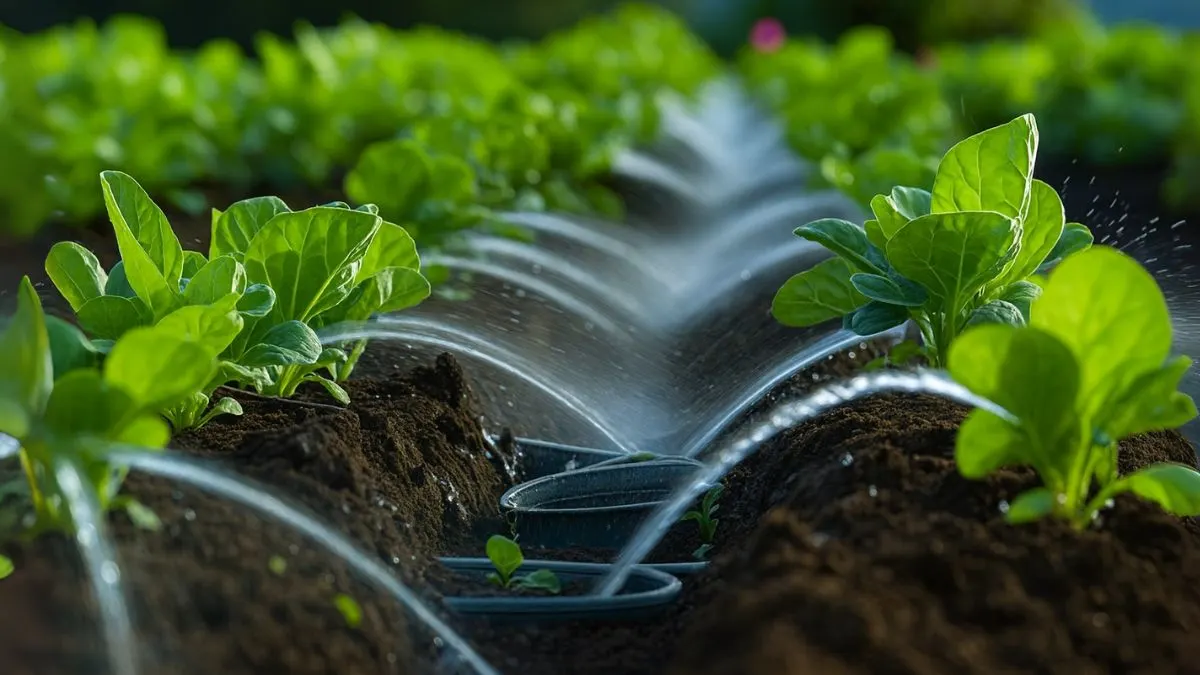Water is the lifeline of every garden, but how you deliver it makes a world of difference. Traditional watering methods like sprinklers or hoses often waste water and increase the risk of diseases. That’s where drip irrigation for vegetable gardens comes in. By delivering water directly to the soil near the roots, this method saves water, reduces weeds, and keeps plants healthier.
Why Choose Drip Irrigation?

- Efficiency: Uses up to 50% less water than sprinklers.
- Healthier plants: Drip irrigation is a great option for disease prone plants since it keeps foliage dry.
- Flexibility: Works for raised beds, containers, and large garden plots.
- Convenience: Once installed, it requires minimal effort to maintain.
- Better yields: Consistent soil moisture leads to healthier crops and more harvest.
When I switched from overhead watering to drip irrigation in my vegetable garden, I noticed fewer fungal infections on tomatoes and peppers. My plants stayed healthier, and my water bill dropped noticeably.
How Drip Irrigation Works
The system is simple:
- A main hose runs through your garden.
- Smaller tubes branch off to deliver water near the roots.
- Emitters release controlled amounts of water at each plant.
Essentially, drip irrigation works by placing tubing with emitters on the ground along side the plants. These emitters ensure water trickles slowly into the soil, targeting the roots where it’s needed most.
Also Read: Ghost Plants Are Real—And They’re Hauntingly Beautiful!
Key Benefits for Vegetable Gardens
1. Disease Prevention
Overhead watering wets the leaves, encouraging fungal infections like blight and mildew. With drip irrigation, water goes directly into the soil, keeping foliage dry. This is why drip irrigation is a great option for disease prone plants like tomatoes, cucumbers, and peppers.
2. Water Conservation
Since water is delivered directly to the roots, very little is lost to evaporation or runoff. In fact, studies show drip irrigation can save up to 70% water compared to sprinklers.
3. Better Root Growth
Roots grow stronger and deeper when moisture is consistent. Unlike hoses that flood one spot, emitters drip slowly, allowing soil to absorb water gradually.
4. Flexibility Across Garden Types
Whether you’re growing carrots in raised beds, beans in rows, or cucumbers in containers, drip systems can be customized to fit.
Setting Up Drip Irrigation in Your Garden
1: Plan Your Layout
- Sketch your garden.
- Identify main rows and beds.
- Decide where to run the main line and smaller branches.
2: Install the Main Hose
- Lay down a strong hose along your vegetable beds.
- Connect it to a water source or a garden faucet.
3: Add Tubing with Emitters
- Place branch tubes with emitters near each plant.
- Remember: placing tubing with emitters on the ground along side the plants ensures water reaches roots effectively.
Also Read: Sahadevi Plant: The Hidden Vastu Herb That Attracts Positivity & Healing
4: Regulate Flow
- Use emitters with different flow rates for different plants. Leafy greens like lettuce need more frequent watering, while root crops like carrots need less.
5: Test the System
- Turn on water and check for leaks.
- Make sure all emitters drip consistently.
Plants That Benefit Most
Vegetable plants across Canada, the USA, and India thrive with drip irrigation. Some of the best candidates include:
- Tomatoes – sensitive to fungal diseases from wet leaves.
- Peppers – need consistent moisture for fruiting.
- Cucumbers & Squash – disease-prone vines that benefit from dry foliage.
- Leafy Greens – like lettuce, spinach, and kale, which require steady moisture.
- Root Vegetables – such as carrots and radishes, where deep watering strengthens roots.
Cost and Maintenance
- Initial setup costs more than hoses, but long-term savings on water and healthier plants make it worthwhile.
- Maintenance involves flushing out tubing occasionally to prevent clogs.
- Filters and regulators should be checked every season.
Personal Experience
When I installed drip irrigation in my raised beds for the first time, I underestimated how much easier it would make gardening. With just one adjustment of the timer, my plants received water consistently—even when I was away. My tomato plants, usually plagued by blight, remained healthy, proving firsthand that drip irrigation is a great option for disease prone plants.
Also Read: Sanjeevani Plant: The Ancient Herb That Could Save Lives?
Key Requirements for Drip Irrigation
Requirement |
Details |
Method |
Placing tubing with emitters on the ground along side the plants |
Benefits |
Water efficiency, disease prevention, better yields |
Best for |
Disease prone plants like tomatoes, peppers, cucumbers |
Watering |
Slow and consistent moisture at root zone |
Maintenance |
Flush tubing, check emitters, clean filters regularly |
If you’re serious about healthier vegetables and smarter water use, drip irrigation is worth every penny. Whether you garden in Canada, the USA, or India, drip irrigation can transform the way you grow vegetables.






